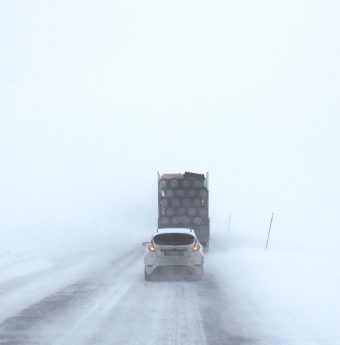Winter Driving Safety Tips You Wish They Taught You
/ 5 Stars read 3 min

The thought of taking to the icy roads during Winter when you’ve never driven them is an anxiety-inducing experience.
Whether you moved to an area that gets snow or a first-time driver, Winter driving is no walk in the park.
It takes practice, patience, and skill to navigate the roads when they’re covered in snow.
Before this post’s end, you’ll learn a variety of winter driving safety tips to help keep you safe on the roads.
Let’s learn how to handle the vehicle when severe weather hits.
Safe Winter Driving: 10 Tips for the Cold Commute
Many will wait to take their driving test and apply for a license during the warmer months because it’s easier.
Unfortunately, this doesn’t provide winter driving experience until the snow starts falling. By then, you’re on your own and this is quite the frightening experience when it’s coming down hard.
Here’s what you should know:
- Stay at home. Road dangers increase the more time you’re on the road. Ask yourself if you need to make a quick trip to the store. If you can, try to delay the trip for when the weather is better if possible.
- Get the vehicle serviced. Get a full inspection of the vehicle including the battery, fluid, tires, lights, coolant, and the like. Repair what you can so you’re less likely stranded if/when it breaks down. Likewise, make an emergency roadside kit just in case you’re snowed in.
- Plan the route. Like staying at home to avoid conditions, plan the route so you minimize potential troubles. Check your local weather for road closures and accidents so you can avoid the mess. Use the safest route to the location versus what may be the fastest.
- Be careful warming up. Don’t warm up the vehicle in an enclosed space like the garage. This puts out dangerous fumes that could prove fatal! Either open the garage door or let it idle in the driveway.
- Stay topped up. Don’t let the gas get too low in case of a line freeze or if you’re suddenly stranded. Try keeping the tank at least half full but topping up is better if you have the time/money.
- Use your signals. Visibility conditions drop when flurries happen so make sure you’ve got the lights on and you’re using signals. Give each other ample space to merge and prepare to slow down or stop.
- Double the distance. Icy roads and lower traction are accidents waiting to happen, reduce this by doubling the spacing when behind vehicles. Go for 4 car lengths so you have ample time to react and slow down. Space also gives enough space in case you begin to slide.
- Take your time. Get a feel for how the vehicle controls during snowy and icy conditions so you can adapt. Likewise, pace yourself going up and down hilly areas and taking turns.
- Practice safe driving. Always use a seatbelt, secure loved ones, and avoid distracted driving. Stay alert and never drive under the influence. And, obey traffic signs and road rules.
- Stay calm. Stalled or broken down? Turn on your hazards, dome light, or set out flares/reflectors. Stay with the vehicle and don’t step out onto the road. Call the appropriate authorities and stay warm until they arrive.
We’d also recommend practicing winter driving in safe areas like an empty parking lot or if you have access to private roads. This will help you get a feel for the vehicle and lets you practice these winter driving safety tips.
Remember: Driving during the Winter is a challenging task, it’s easy feeling frustrated as traffic slows, visibility drops, and anxiety picks up. Take your time, be patient, and stay alert. This calmness will keep you safe.



